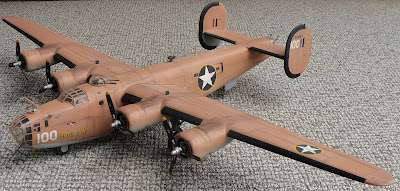




Here are some images of Monogram's 1/48 scale Consolidated B 24 D Liberator (Pregnant Cow). This model represents the aircraft Teggie Ann which took part in the raid on the Ploesti oilfields in Romania during world war two. If you wish to read more on Ploesti you may do so here.
From Wikipedia"
The Consolidated B-24 Liberator was an American heavy bomber, designed by Consolidated Aircraft Company of San Diego, California. Its mass production was brought into full force by 1943 with the aid of the Ford Motor Company through its newly-constructed Willow Run facility, where peak production had reached one B-24 per hour and 650 per month in 1944. Other factories soon followed. The B-24 ended World War II as the most produced Allied heavy bomber in history, and the most produced American military aircraft at over 18,400 units, due largely to Henry Ford and the harnessing of American industry. It still holds the distinction as the most-produced American military aircraft. The B-24 was used by several Allied air forces and navies, and by every branch of the American armed forces during the war, attaining a distinguished war record with its operations in the Western European, Pacific, Mediterranean, and China-Burma-India Theaters.
Often compared with the better-known B-17 Flying Fortress, the B-24 was a more modern design with a higher top speed, greater range, and a heavier bomb load; however, it was also more difficult to fly, with heavy control forces and poor formation-flying characteristics. Popular opinion among aircrews and general staffs tended to favor the B-17's rugged qualities above all other considerations in the European Theater. The placement of the B-24's fuel tanks throughout the upper fuselage and its lightweight construction, designed to increase range and optimize assembly line production, made the aircraft vulnerable to battle damage. The B-24 was notorious among American aircrews for its tendency to catch fire. Moreover, its high fuselage-mounted Davis wing also meant it was dangerous to ditch or belly land, since the fuselage tended to break apart. Nevertheless, the B-24 provided excellent service in a variety of roles thanks to its large payload and long range.
The B-24's most famous mission was the low-level strike against the Ploesti oil fields, in Romania on 1 August 1943, which turned into a disaster because the enemy was underestimated, fully alerted and attackers disorganized.

10 comments:
Very nice scheme, and well done.
Ploesti was a hard blow in the fuel reserve of german side. This plane is a very good kit, a little bit old but, I like in this way.
Thanks Pablo - This is the Pro Modeller version of this kit as it came with a fair amount of photoetched parts.
I know but the initial model was a Monogram kit.It isn't so?
Nice plane and nice version. I've never worked with Monogram, I think. I have a version of Hasegawa climbing · 1:72 ... someday I will
Yes it is Pablo.
Grcias Diego.
Hi Warren,
Very nice. I'm building one of these Ploesti raiders in 1/72. What colors did you use?
Dave
Hi Warren,
There's going to be a DVD coming out about the Ploesti raid. It should be about two hours worth of material. It may be available by the end of 2012.
I think the subject would be great for a movie.
Dave
I found that the Testors desert sand that comes in the little square bottles was a perfect match.
I can't wait to see it. the Ploesti raid was considered a disaster on the Allies part. Those refineries were were back up and running again within a few days.
Post a Comment